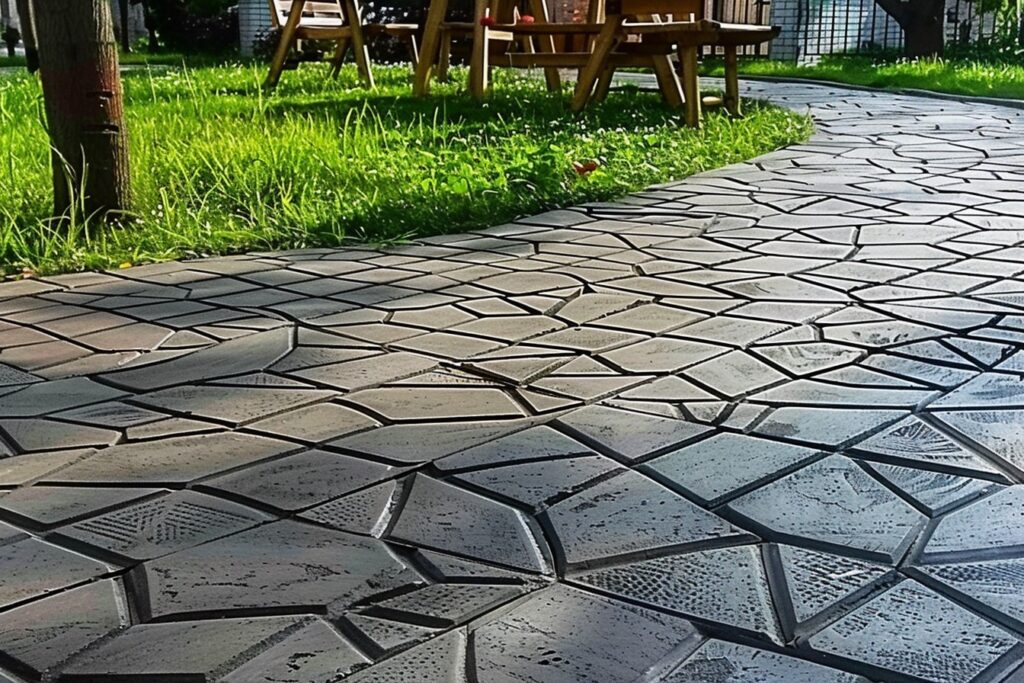Stamped vs. Polished Concrete: A Complete Guide to Choosing the Perfect Finish for Your Home

Concrete has evolved far beyond its traditional utilitarian purpose. Today, it is a versatile material that can transform spaces with both functionality and style.
Stamped and polished concrete are two popular finishes, each offering unique benefits and aesthetic options.
This guide will help you understand the differences between these finishes, their advantages, and how to decide which is right for your home.
Why Choosing the Right Concrete Finish Matters
The right concrete finish enhances the functionality and appearance of your space while aligning with your budget and maintenance preferences.
Selecting between stamped and polished concrete depends on factors like usage, durability, and personal style.
What is Stamped Concrete?
Stamped concrete involves imprinting patterns, textures, and colors onto freshly poured concrete.
This process mimics the appearance of natural materials such as stone, brick, or wood.
Advantages of Stamped Concrete
Aesthetic Versatility: Offers a wide range of patterns and textures.
Cost-Effective: Provides the look of high-end materials at a lower cost.
Durable: With proper maintenance, it can withstand outdoor elements.
Common Applications of Stamped Concrete
Walkways and Driveways
Pool decks and entertainment areas
What is Polished Concrete?
Polished concrete is achieved by mechanically grinding and polishing the surface with fine abrasives, resulting in a smooth, glossy finish.
Advantages of Polished Concrete
Modern Appearance: Provides a sleek and contemporary look.
Low Maintenance: Requires minimal cleaning and upkeep.
Eco-Friendly: Improves energy efficiency by reflecting natural light.
Common Applications of Polished Concrete
Indoor floors
Commercial and retail spaces
Industrial facilities
Aesthetic Comparison
Stamped Concrete
Mimics natural materials like stone, slate, or wood.
Best suited for outdoor settings.
Polished Concrete
Offers a minimalist, reflective finish.
Ideal for modern and industrial interior designs.
Durability and Maintenance
Stamped Concrete
Requires sealing every few years to prevent fading and wear.
Susceptible to cracking without proper installation and maintenance.
Polished Concrete
Highly durable and resistant to stains and scratches.
Requires occasional re-polishing to maintain its glossy finish.
Cost Comparison
Stamped Concrete
Typically more affordable upfront.
Long-term costs may increase due to regular resealing.
Polished Concrete
Higher initial cost due to labor-intensive polishing.
Long-term savings on maintenance.
Installation Process
Stamped Concrete
Concrete is poured, stamped with patterns, and sealed.
Process is quicker but weather-dependent.
Polished Concrete
Involves grinding, honing, and polishing multiple times.
Time-intensive but provides a high-quality finish.
Environmental Impact
Stamped Concrete
Can be eco-friendly when combined with sustainable materials.
Polished Concrete
Improves energy efficiency by increasing natural light reflectivity.
Slip Resistance and Safety
Stamped Concrete
Texture can provide better grip but may become slippery when wet.
Polished Concrete
Smooth surface may require anti-slip treatments, especially in wet areas.
Weather and Climate Considerations
Stamped Concrete
Performs well outdoors but may crack in extreme weather.
Polished Concrete
Best suited for indoor environments where weather is not a concern.
Customization Options
Stamped Concrete
Wide variety of patterns, colors, and textures.
Polished Concrete
Customizable with stains, dyes, and exposed aggregates.
Lifespan Expectations
Both finishes are long-lasting with proper installation and maintenance. Stamped concrete typically lasts 20-25 years, while polished concrete can last even longer indoors.
Common Myths and Misconceptions
Stamped Concrete
Myth: It always looks fake.
Fact: High-quality stamping closely mimics natural materials.Myth: It cracks easily.
Fact: Proper installation and maintenance prevent cracking.
Polished Concrete
Myth: It is always cold.
Fact: Its temperature depends on the environment and can be supplemented with radiant heating.Myth: It scratches easily.
Fact: It is highly scratch-resistant when properly polished.
Choosing the Right Option for Your Home
Factors to Consider
Indoor vs. outdoor application
Budget and maintenance preferences
Desired aesthetic style
When to Choose Stamped Concrete
Outdoor spaces with decorative designs.
Projects requiring a natural or rustic appearance.
When to Choose Polished Concrete
Indoor spaces with a modern, sleek look.
Areas requiring low maintenance and high durability.
Summary and Key Takeaways
Stamped concrete excels in outdoor applications with its decorative versatility, while polished concrete is perfect for indoor spaces with a modern aesthetic. Consider your specific needs, budget, and style to make the right choice.
Frequently Asked Questions (FAQs)
Can stamped concrete be used indoors?
Yes, but it is more commonly used outdoors for patios, driveways, and walkways.
Is polished concrete suitable for outdoor spaces?
Polished concrete is generally better for indoor use but can work outdoors in mild climates with proper sealing.
How often should stamped concrete be resealed?
It typically requires resealing every 2-3 years, depending on usage and exposure.
Does polished concrete need special cleaning products?
No, regular sweeping and mopping with a mild cleaner are usually sufficient.
Which option is more pet-friendly?
Both options are pet-friendly, but polished concrete may be easier to clean for indoor messes.
If you’re ready to enhance your space with the perfect concrete finish, contact our team today for expert advice and a free quote. Let us help you create a space that combines beauty, durability, and functionality!
